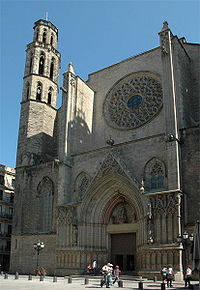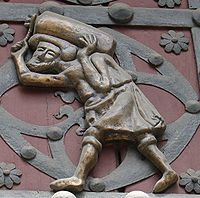- Santa Maria del Mar, Barcelona
-
This article is about the church in Barcelona. For other uses, see Santa María del Mar (disambiguation).
Santa Maria del Mar (Catalan pronunciation: [ˈsantə məˈɾi.ə ðəɫ ˈmar]) is an imposing church in the Ribera district of Barcelona, Spain, built between 1329 and 1383 at the height of Catalonia's maritime and mercantile preeminence. It is an outstanding example of Catalan Gothic, with a purity and unity of style that are very unusual in large mediaeval buildings.[1]
Contents
History
The first mention of a church of Santa Maria by the sea dates from 998. The construction of the present building was promoted by the canon Bernat Llull, who was appointed Archdean of Santa Maria in 1324. Construction work started on 25 March 1329, when the foundation stone was laid by king Alfonso IV of Aragon, as commemorated by a tablet in Latin and Catalan on the facade that gives onto Fossar de les Moreres. The architects in charge were Berenguer de Montagut (designer of the building) and Ramon Despuig, and during the construction all the guilds of the Ribera quarter were involved.[1] The walls, the side chapels and the facades were finished by 1350. In 1379 there was a fire that damaged important parts of the works. Finally, on 3 November 1383 the last stone was added and on 15 August the first mass was celebrated[citation needed]. In 1428 an earthquake caused several casualties and destroyed the rose window in the west end.[2] The new window, in the Flamboyant style, was finished by 1459[1] and one year later the glass was added. The images and the Baroque altar were destroyed in a fire in 1936. The chapel of the Blessed Sacrament, adjacent to the apse, was added in the 19th century.[2]
Exterior
From the outside, Santa Maria gives an impression of massive severity that belies the interior. It is hemmed in by the narrow streets of the Ribera, making it difficult to obtain an overall impression, except from the Fossar de les Moreres and the Plaça de Santa Maria, both of them former burial grounds. The latter is dominated by the west end of the church with its rose window. Images of Saint Peter and Saint Paul occupy niches on either side of the west door, and the tympanum shows the Saviour flanked by Our Lady and Saint John.
The north-west tower was completed in 1496, but its companion was not finished until 1902.;[2][1]
Interior
In contrast with the exterior, the interior gives an impression of light and spaciousness. It is of the basilica type, with its three aisles forming a single space with no transepts and no architectural boundary between nave and presbytery. The simple ribbed vault is supported on slender octagonal columns, and abundant daylight streams in through the tall clerestorey windows.
The interior is almost devoid of imagery of the sort to be found in Barcelona's other large Gothic churches, the cathedral and Santa Maria del Pi, after the fire which occurred in 1936 during anticlerical disturbances. Amongst the most notable of the works destroyed at that time was the Baroque retable by Deodat Casanoves and Salvador Gurri.
Some interesting stained-glass windows have survived from various periods.[1][2]
The church has a serious claim to have the slenderest stone built columns in the world.[citation needed]
Proportions
According to the art historian Josep Bracons,[3] the basic unit of measurement used in Santa Maria del Mar was the mediaeval foot of 33 centimetres. Measured in this way, the side chapels are 10 feet deep, the width of the side aisles is double this, while the central aisle is four times as wide, that is, 40 feet. The total width of the church is thus 100 mediaeval feet, which is also equal to the maximum height of the building.
In popular culture
The construction of Santa Maria del Mar is the background for the best-selling novel La catedral del mar, by Ildefonso Falcones (2006).
References
- ^ a b c d e Cirici, Alexandre. Barcelona paso a paso, Barcelona, Editorial Teide, S.A. 2nd ed., 1981
- ^ a b c d Hernàndez-Cros, Josep Emili (ed.). Catàleg del Patrimoni Arquitectònic Històrico-Artístic de la Ciutat de Barcelona, Barcelona, Ajuntament de Barcelona, 1987
- ^ Bracons, Josep, "Bellesa, harmonia i proporció", Quadern supplement to El País, Barcelona ed., 9.11.2006
External links
Barcelona landmarks Buildings and
interesting places:Arc de Triomf · Avinguda Diagonal · Barcelona Pavilion · Bellesguard · Biblioteca de Catalunya · Casa Amatller · Casa Batlló · Casa Calvet · Casa de l'Ardiaca · Casa Fuster · Casa Lleó-Morera · Casa Milà · Casa Terrades · Casa Vicens · Castell dels Tres Dragons · Cathedral of Santa Eulalia · Columbus Monument · Dona i Ocell · Drassanes Reials · Els Quatre Gats · Estació de França · Fabra Observatory · Font de Canaletes · Forum Building · Fossar de les Moreres · Fundació Joan Miró · Hospital de Sant Pau · Hospital de Sant Pau · Hotel Arts · Hotel Habitat Sky · IMAX Barcelona · Jewish quarter · Jonqueres Monastery · La Boqueria · L'Auditori · L'Illa · Magic Fountain of Montjuïc · Mercat del Born · Mercat de Sant Antoni · Montjuïc Castle · Montjuïc Communications Tower · Olympic Harbour · Olympic Ring of Barcelona · Palau del Baró de Quadras · Palau Episcopal de Barcelona · Palau Güell · Palau de la Generalitat de Catalunya · Palau Reial Major · Palau Robert · Palau de la Virreina · Parliament of Catalonia · Pedralbes Monastery · Poble Espanyol · Sagrada Família · Sagrat Cor · Sala de les Cent Columnes · Santa Maria del Mar · Santa Maria del Pi · Torre Agbar · Torre de Collserola · Vapor Vell · World Trade Center Barcelona
Streets and squares: Avinguda Diagonal · Carrer d'Avinyó · Carrer Ferran · Carrer Tallers · Gran Via de les Corts Catalanes · La Rambla · Passeig de Gràcia · Plaça de Catalunya · Plaça d'Espanya · Plaça Reial · Plaça Sant Jaume · Plaça de Sant Felip Neri · Rambla de CatalunyaMuseums: Archaeology Museum of Catalonia · Caixafòrum · CCCB · CosmoCaixa Barcelona · Fundació Antoni Tàpies · Gracia Arts Project · Institut Botànic de Barcelona · Jardí Botànic · MACBA · Museu de les Arts Decoratives · Museu Castell de Montjuïc & Museu Militar · Wax museum · Museu de Ceràmica · Museu de la Ciència · Egyptian Museum · Museu de l'Eròtica de Barcelona · Museu Etnològic · Museu Frederic Marès · Museu d'Història de Catalunya · Museu d'Història de la Ciutat · Maritime Museum · Museu del Modernisme Català · Museu de la Música · Museu Nacional d'Art de Catalunya · Museu del Perfum de Barcelona · Museu Picasso · Museu Tèxtil i d'Indumentària · Museu de la XocolataSports: Camp Municipal Narcís Sala · Camp Nou · Camp de Les Corts · Estadi de Sarrià · Estadi Olímpic Lluís Companys · Mini Estadi · Palau dels Esports · Palau Blaugrana · Palau Sant JordiPerforming arts: Gran Teatre del Liceu · L'Auditori · Palau de la Música Catalana · Teatre Apolo · Teatre Grec · Teatre Lliure · Teatre Poliorama · Teatre RomeaParks: Laberint d'Horta · Parc de les Aigües · Parc de la Ciutadella · Parc de Diagonal Mar · Parc de l'Espanya Industrial · Park Güell · Parc de la Creueta del Coll · Parc Joan Miró · MontjuïcZoos: Beaches: Barceloneta beach · Bogatell beach · Mar Bella beach · Nova Icària beach · Nova Mar Bella beach · Sant Sebastià beachCategories:- Churches in Barcelona
- 14th-century architecture
- Ciutat Vella (district of Barcelona)
- Basilica churches in Spain
- Gothic architecture in Spain
Wikimedia Foundation. 2010.





